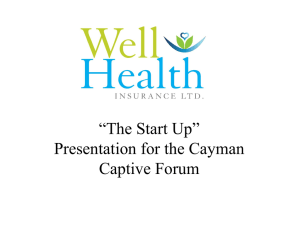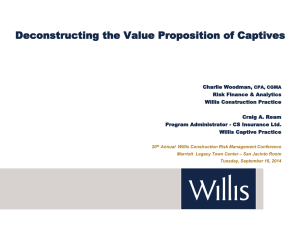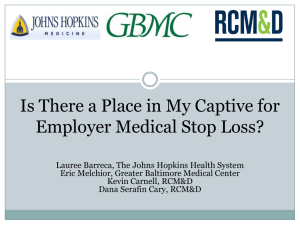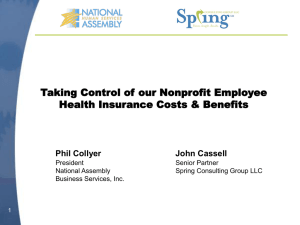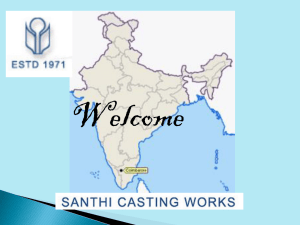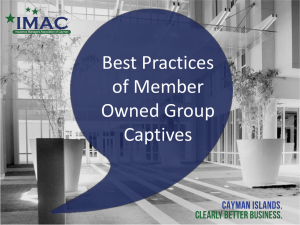Captives: An Ideal Place for All Types of Stop Loss presentation files
advertisement
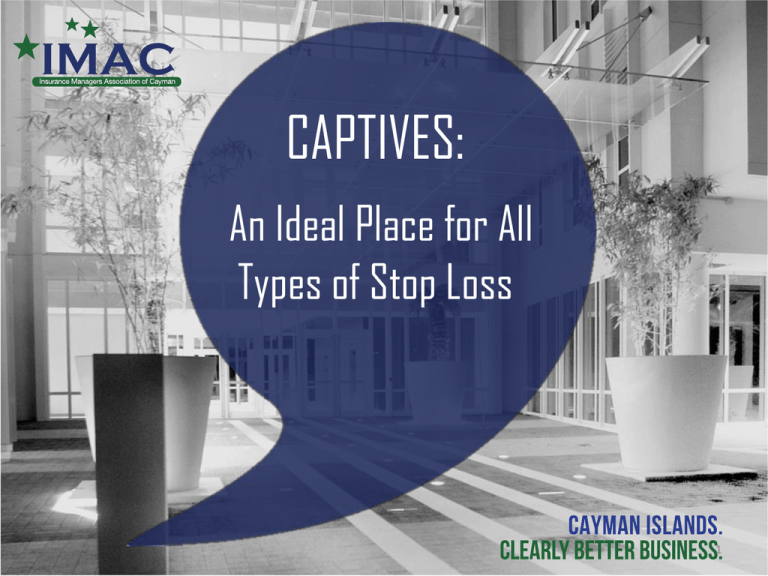
CAPTIVES: An Ideal Place for All Types of Stop Loss 1 Dan H. Carlson Marsh USA Inc. - Managing Director Gary J. Bischel Guy Carpenter - Managing Director Jay B. Waters University Hospitals - VP-Corporate Risk Management 2 DISCUSSION OUTLINE “Setting the Table” Dan H. Carlson Marsh “Hands-On” Experiences - Provider Excess Loss Insurance & Employer Stop Loss Captives Gary J. Bischel Guy Carpenter - University Hospitals, OH Employer Stop Loss Captive Program Jay B. Waters University Hospitals Summary / Questions 3 “SETTING THE TABLE“ Stop Loss “101“ Healthcare Reform – Evolving Risk Industry Trends / Dynamics Large Medical Claims Dan H. Carlson Marsh USA Inc. - Managing Director 4 STOP LOSS...a loosely used term • Employer Stop Loss (ESL) • For employers with a self-funded (ASO) employee benefit plan • Provider Stop Loss Insurance (PSL) Provider Excess Loss Insurance (PEL) Provider Excess Insurance (PEI) • For “at-risk” healthcare providers that are accepting risk through capitation, bundled payments, or global payments, plus ACOs) • Health Plan (HMO) Reinsurance • For reinsuring a health plan’s large catastrophic medical claims of covered members 5 “STOP LOSS” Typical Coverage Retention (Deductible) $100,000 - $1M or higher (annual per person) Coinsurance Payable 90% or 80% (after the retention) Covered Services Global, specific services (i.e. hospital-inpatient, outpatient, professional, pharmacy, etc.) Reimbursement Level Contracted amount or amount paid Maximum Benefit $1M, $2M, $3M, $5M, $10M, or Unlimited Other Membership size/type, utilization data, provider contracts, and claims experience 6 TYPES OF PATIENT “POPULATIONS” • Commercial » Individual Products • Including Health Insurance Co-Ops » Employee Benefit Plans (Group Insurance) Products • • • • • Health Plan or Health Maintenance Organization (HMO) Point-of-Service (POS) Preferred Provider Organizations (PPO) Accountable Care Organizations (ACOs) Administrative Services Only (ASO) with Employer Stop Loss (ESL) • Medicare • Medicaid (AFDC/TANF, ABD, SSI, etc.) • “Dual Eligibles” (Medicare and Medicaid) 7 HEALTHCARE REFORM Evolving Risk… • Commercial Health Plans – No pre-existing conditions underwriting – Phasing in of no annual & lifetime maximums – Covering children to age 26 – Medical Loss Ratio (MLR) pressures 8 HEALTHCARE REFORM Evolving Risk… • Medicare / Medicare Advantage – Formation of Accountable Care Organizations (ACOs) – CMS Shared-Savings Risk Pools – Reduced reimbursements – Patient Centered Medical Homes (PCMH) & Medical Neighborhoods 9 HEALTHCARE REFORM Evolving Risk… • Medicaid Health Plans – Expanded geographies / eligibility – Dealing with significant covered population increases - Network & Administrative Adequacy Challenges !! – Long term funding given State and Federal budget constraints 10 INDUSTRY DYNAMICS / TRENDS Provider Contracting • ACO-Type Contracts for Commercial Populations • Accountable Care Organizations (ACOs) – Specific Provider Excess Loss Insurance – Aggregate Provider Excess Loss Insurance for “Pioneer” ACOs • Bundled Payments (hip & knee replacements) • Provider Direct Contracting with Employers • Risk-Taking Specialty Providers (Cancer Treatment) • Health Insurance Exchanges – Including New Health Co-Ops – BEWARE: New and Unknown Patient Populations 11 LARGE MEDICAL CLAIM TRENDS Beware… • Continued concern over increasing FREQUENCY and SEVERITY of catastrophic claims - Neonates - Hepatitis C - ESRD - Biotech cancer drugs - Hemophiliacs (blood factor) - Organ transplants / re-transplantations • Some carrier and client loss ratios are deteriorating. • Healthcare providers are attempting to negotiate higher reimbursements from health plans • THE RESULT: Increase in risk and the potential for market-driven increasing reinsurance premiums 12 STEPS LEADING TO THE CAPTIVE OPTION Premium Funding Continuum • Fully Insured with Experience Refund • • Monthly per member per month (PMPM) premium payment Premium Funding Alternatives (cash flow advantages) • Retro-Claims Corridor » Shared claims risk with insurer – the “middle” layer • Other » “Aggregating Specific” and “Inner-Aggregate” • Use of Captive 13 CARRIER MARKET DYNAMICS GOOD NEWS • Carriers are preparing for the formation of new risk-bearing entities such as ACOs, and the migration from fee-for-service to value-based “at-risk” revenue compensation models. • They are more receptive to new types of risk opportunities. • New carrier entrance • “Direct writers” are considering expanded distribution strategies • Adding staff 14 CARRIER MARKET DYNAMICS Is it time to consider placing this coverage in your captive? BAD NEWS • Carriers are fine-tuning their risk appetite. • Carriers have more selective distribution strategies (limiting insurance broker access). • “Seasoned” underwriters are aware of your historical purchasing practices. • Administration margins can be up to 40%! 15 “Hands On“ Experience Provider Excess Loss & Employer Stop Loss Captives Gary J. Bischel Guy Carpenter - Managing Director 16 Captive Stop Loss Programs Motivated by Historical Frustration • Trading dollars with their stop loss carrier and consistently finding themselves on the losing end • Being restricted by provisions within the filed insurance products available to them • Lacking “linkage” between finance, care management, human resources, etc. • Struggling to find ways to effectively increase utilization of their captive 17 Captive Stop Loss Programs Common Objectives Create a risk management scheme which provides: • The ability to reap the benefits of their own success in managing claims • A mechanism for which to manage the desired amount of retained exposure while at the same time controlling the reinsurance markets • A reduction of frictional costs (premium tax, carrier loads, etc.) of risk transfer • Introduction of uncorrelated, short-tail, 1st party exposures which are complimentary to the captive’s portfolio. 18 Captive Stop Loss Programs Important Considerations The ability to properly analyze the subject risk to: • Quantify its volatility • Create an optimal coverage scheme • Determine appropriate captive funding levels • Dictate pricing/terms to the reinsurance markets Coordination of resources to satisfy numerous interested parties • Regulatory authorities • Captive Boards Commitment across multiple organizations to the short term effort and long term success of the program 19 Captive Stop Loss Programs Consistent Results • Reduced hard dollar “all in” cost • Significant (25%+) reduction in premium spend to external (re)insurer • Potential for significant surplus contribution to captive • Improved financial results (i.e. lower net cost of reinsurance) across continuum of loss scenarios • Upside-only exposure for captive • Risk corridor is often fully funded • Potential to earn a positive investment return on those premiums 20 “Hands-On” Experience Employer Stop Loss Captive Program Jay B. Waters University Hospitals - VP-Corporate Risk Management 21 UNIVERSITY HOSPITALS Historical Information • Self-Funded Employee Medical Benefit Program • 25,000 Lives • Third Party Administrative Services • $500K per Claim Retention • Employer Stop Loss Provided by Administrator • • • • • Nominal Premium $2M per Claim Excess of Retention / No Aggregate No Exposure to Employer over $2.5M Lifetime Maximum Excluded Pharmaceuticals Recovered 80% of UH Costs 22 UNIVERSITY HOSPITALS Historical Information • 2011 Formed Accountable Care Organization • Covers All Employees • 2011 Healthcare Reform Eliminates Lifetime Maximum • Financial Exposure Excess of $2.5M • Selected New Administrator • Employer Stop Loss Coverage Not Offered • Cost of Commercial Stop Loss Coverage Doubles • Captive Asked to Evaluate Providing Coverage 23 UNIVERSITY HOSPITALS Evaluation – Claims History • Actuarial / Consultant Review (Loss Cost Funding) • Internal Claims Analysis (2009 Year ~ 1 Claim for $2.4M) • Overall Favorable Loss Experience University Hospitals Claims History Year 2007 2008 2009 2010 2011 Average Aggregate Claim Value Trended (000) $0 $977,000 $3,167,000 $233,000 $100,000 $50,000 $2,287,000 $3,854,000 $448,000 $148,000 $895,400 $1,357,400 24 UNIVERSITY HOSPITALS Evaluation (Continued) • State of Employee Health • Accountable Care Organization » Wellness Programs ~ Improving Employee Health » Oversight of Claims by UH Nurse Case Managers • Anticipated Improvements in Frequency and Severity • Pricing • Actuarial / Consultant Review » Estimated Premium • Broker Quotations » Commercial Insurer Quotations 25 UNIVERSITY HOSPITALS Captive Program • $3M Annual Aggregate • $500K Retention • 15 / 12 Contract Term • 100% Recovery of UH Costs • Pharmaceuticals Included • Commercially Comparable Coverage and Premium 26 UNIVERSITY HOSPITALS Captive Program Results • Significant Improvement in Recovery • Policy Surplus University Hospitals Recovery History Year Total Claims Including Pharmaceuticals Recovery Under Captive Recovery Under Commercial Coverage @ 80% Claims Excess Retention Annual Premium 2012 $6,327,722 $615,257 $615,257 $0 $1,500,000 2013 $9,911,786 $963,720 $963,720 $0 $1,000,000 27 UNIVERSITY HOSPITALS Captive Program - 2 New Policies Written in 2014 - 31,000 Lives in 2014 28 SUMMARY • Understand your organization’s risk tolerance • Know the risk that your captive will assume • Engage leaders across the organization to ensure visibility, buy-in, and ultimately success • Monitor the changing external healthcare environment • Care management is critical 29 30

